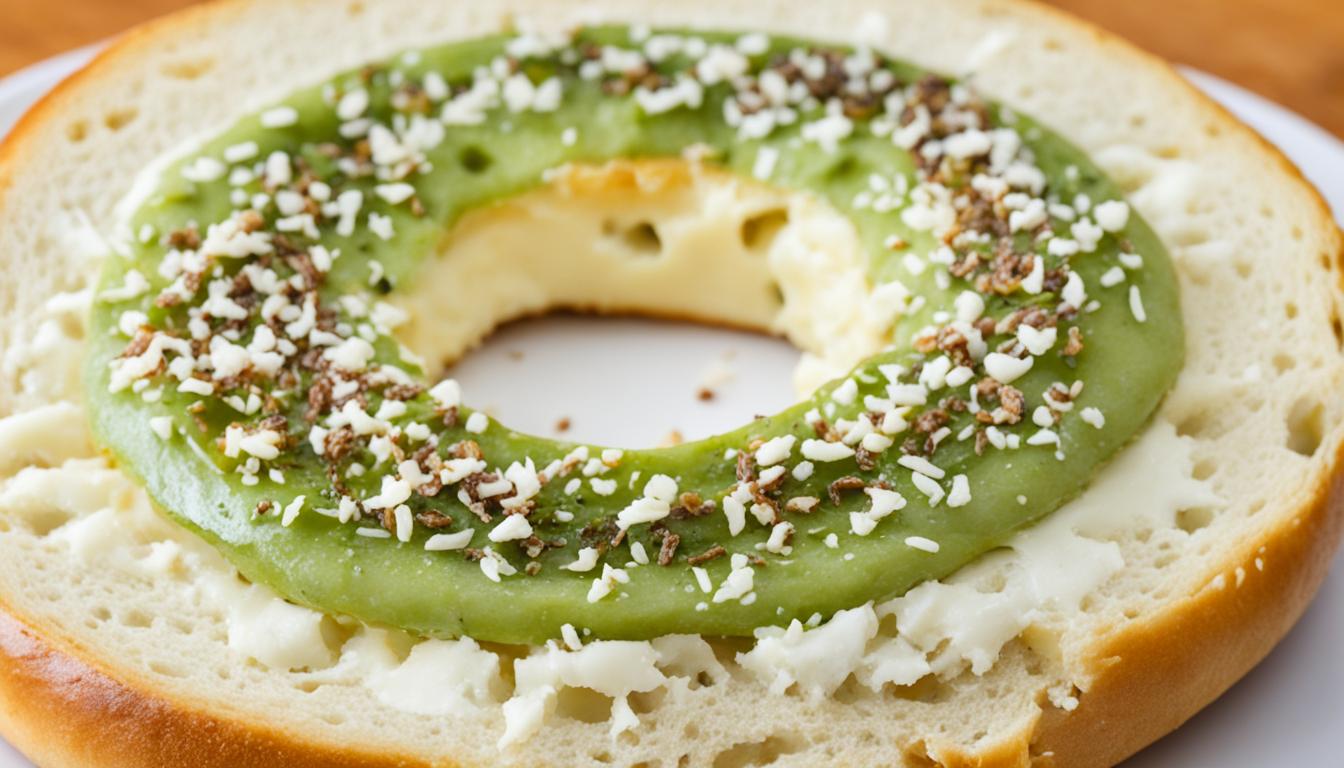Have you ever tried making homemade bagels only to be disappointed by the result? Do your bagels turn out with uneven shapes, dense textures, or lackluster flavors? If so, you’re not alone. The process of making bagels can be tricky, and there are numerous potential pitfalls along the way. But fear not! We’re here to help you troubleshoot and fix any issues you may encounter, so you can achieve bakery-worthy bagels right from your own kitchen.
Key Takeaways:
- Bagel balls can be prevented by stretching the dough into a wide ring and ensuring proper proofing time.
- Proper shaping techniques and avoiding mix-ins can prevent blowouts and create crispy, crackly micro-bubbles on the surface of the dough.
- Poor gluten development can result in bagels without desired blisters, but kneading the dough properly can help.
- Maintaining the proper water temperature and boiling techniques are crucial for bagel rise and texture.
- Overworking the dough can result in a dense ring with a tight crumb, so be careful not to mix it excessively.
Bagel Balls
One common problem encountered when making homemade bagels is the formation of bagel balls. Bagel balls are small, dense areas that appear in the center of the bagel, disrupting its desired texture and appearance. There are a few common causes for this issue that we can troubleshoot and fix.
Causes of Bagel Balls
Bagel balls can occur due to two main factors:
- Insufficient dough stretching: When the dough is not stretched into a wide enough ring, it can result in bagel balls. The dough must be properly shaped and stretched to ensure an even distribution of dough throughout the bagel.
- Under-proofing: Proper proofing is crucial for bagel making. If the dough is under-proofed, it does not have enough time to rise and develop the desired texture. This can result in the formation of bagel balls.
https://www.youtube.com/watch?v=g8iqwbRhE_w
To prevent bagel balls, it is important to address these causes and make the necessary adjustments to the dough and proofing process.
Preventing Bagel Balls
Here are some tips to help you troubleshoot and fix bagel balls:
- Stretch the dough adequately: When shaping the dough, ensure that you stretch it into a wide ring. This will help distribute the dough evenly and prevent the formation of bagel balls.
- Proper proofing time: Allow the dough to proof for the recommended time. This will provide enough time for the yeast to ferment and the dough to rise, leading to a better texture and avoiding bagel balls.
- Precise yeast measurement: Accurate measurement of yeast is crucial for the proper fermentation process. Use a digital scale or precise measuring spoons to ensure the right amount of yeast is added to the dough.
By addressing these factors and implementing these fixes, you can troubleshoot and fix bagel balls, resulting in beautifully textured homemade bagels.
| Cause | Solution |
|---|---|
| Insufficient dough stretching | Stretch the dough into a wide ring to ensure even distribution. |
| Under-proofing | Allow the dough to proof for the recommended time to achieve proper rise and texture. |
| Imprecise yeast measurement | Use precise measurements to ensure the right amount of yeast is added. |
Shaping Techniques
Proper shaping techniques are essential for troubleshooting and resolving bagel baking problems. When it comes to achieving the desired texture and appearance of homemade bagels, mastering the art of shaping is crucial. Whether you’re a beginner or a seasoned baker, these tips will help you create perfectly shaped, delicious bagels every time.
Shaping the Dough
Beginners may find it easier to shape the dough into a tight ball first and then poke a hole in the middle to stretch it into a ring. This technique ensures a uniform shape and helps maintain the bagel’s structure during baking. Use your thumbs to create a hole in the middle of the dough ball, then gently stretch it outwards to form the ring shape. If the hole shrinks during shaping, simply stretch it out again. Remember to be gentle and avoid overworking the dough.
Tight Seam
Once the dough is shaped into a ring, make sure to seal the seam tightly. Pinch the ends of the dough together, ensuring there are no gaps or openings. A tight seam helps prevent blowouts during baking, where the bagel may burst open and lose its shape. It also contributes to a better rise and a more uniform texture.
Avoid Mix-Ins
While adding mix-ins like raisins or chocolate chips can be tempting, it’s best to avoid them when troubleshooting bagel baking problems. Mix-ins can disrupt the dough’s structure and make shaping more challenging. They can also lead to uneven cooking and affect the texture of the bagel. Keep your bagels plain for now, and once you’ve mastered the basic shaping techniques, feel free to experiment with different flavors and additions.

By following these troubleshooting tips for shaping homemade bagels, you’ll be able to resolve bagel baking problems and achieve bakery-worthy results. The next section will delve into the importance of gluten development and provide solutions for troubleshooting dough related issues.
Gluten Development
Poor gluten development can result in bagels that lack the desired blisters on the surface. This can occur due to the use of flour with low protein content or when the dough is under-mixed. To troubleshoot and resolve this issue, we recommend properly kneading the dough, either with a food processor or by hand for an extended period of time. This helps develop the gluten, creating a chewy texture with well-formed blisters.
Proper gluten development is essential for achieving the perfect bagel texture. Here are a few solutions to ensure optimal gluten formation:
- Use high-protein flour: Opt for bread flour or high-gluten flour, as they contain more protein compared to all-purpose flour. This higher protein content contributes to better gluten development.
- Extend kneading time: For handmade bagels, knead the dough for at least 10-15 minutes by hand until it becomes smooth, elastic, and slightly tacky. This allows for proper gluten development.
- Utilize a food processor: If you’re using a food processor, process the dough for no less than 2 minutes. This additional processing time helps strengthen the gluten network, resulting in better bagel texture.
Remember, gluten development plays a crucial role in achieving the signature chewiness of bagels. Adequate kneading and using the right flour are the key homemade bagel dough solutions to troubleshoot any issues related to gluten development. By following these tips, you’ll be able to create bagels with the perfect texture and appearance.
Gluten Development Troubleshooting Table
| Problem | Cause | Solution |
|---|---|---|
| Poor blister formation on the bagel surface | Low protein content in the flour Under-mixing the dough |
Use high-protein flour like bread flour or high-gluten flour Properly knead the dough by hand or with a food processor |

Boiling Techniques
When it comes to homemade bagels, the boiling process is a crucial step that can significantly impact the rise and texture of the final product. To ensure your bagels turn out perfectly, it’s important to pay attention to the boiling techniques. Here are some key tips and tricks to troubleshoot any issues you may encounter with your homemade bagel recipe.
The Perfect Water Temperature
The water used for boiling your bagels should be bubbling-hot, not just lukewarm. The boiling water helps to set the outer layer of the dough, resulting in a chewy texture and a crisp crust. Maintaining the proper water temperature is essential, especially when boiling multiple batches of bagels.
Pro Tip: Use a thermometer to ensure the water temperature is around 200°F (93°C) for optimal results.
Boiling Time
Each side of the bagel should be boiled for approximately 40 seconds to a minute. Boiling the bagels too briefly can result in undercooked centers, while boiling them for too long can make them overly dense and tough.
Pro Tip: Set a timer to ensure consistent boiling times for each batch.
Keeping the Water Temperature Consistent
It’s essential to maintain the proper water temperature between batches to ensure consistent results. If the water cools down too much, the bagels may not rise properly or develop the desired texture.
Pro Tip: Have additional boiling water ready to bring the temperature back up if needed.
Avoiding Hotspots
When boiling bagels, make sure they have enough space to freely float in the water. Avoid overcrowding the pot, as this can lead to uneven boiling and result in unevenly cooked bagels.
Pro Tip: Cook the bagels in small batches, giving each one enough room to float and boil evenly.
Visual Troubleshooting Guide
| Issue | Possible Cause | Solution |
|---|---|---|
| Small and Dense Bagels | Boiling bagels in water that is not hot enough | Ensure the water is bubbling-hot and maintain the proper temperature |
| Undercooked Centers | Boiling the bagels for too short of a time | Boil each side of the bagel for approximately 40 seconds to a minute |
| Unevenly Cooked Bagels | Overcrowding the pot while boiling | Cook the bagels in small batches, giving each one enough space to boil evenly |
By following these boiling techniques, you’ll be able to troubleshoot any homemade bagel recipe issues and ensure that your bagels turn out just as delicious as those from a professional bakery.
Overworking the Dough
Overworking the dough while making homemade bagels is a rare but possible mistake that can impact the final outcome. This issue may arise when a half batch is made or when using a high-powered food processor. When the dough is overworked, it fails to retain gas effectively and resists expansion, resulting in a dense ring with a tight crumb.
To fix this problem and achieve optimal results, it is important to ensure proper mixing without overworking the dough. Pay attention to the texture and consistency of the dough as you mix it. It should be smooth, elastic, and slightly tacky to the touch. Overmixing can lead to a less desirable texture and affect the overall quality of the bagels.
Remember, moderation is key when working with bagel dough. Avoid excessive mixing or vigorous kneading, as it can have detrimental effects on the final product. Treat the dough gently, allowing it to rest and rise properly to develop its desired characteristics.
Tips for Avoiding Overworked Dough:
- Follow the recipe instructions carefully, paying attention to the recommended mixing and kneading times.
- If using a food processor, pulse the dough in short intervals instead of continuously running it to prevent overworking.
- If making a half batch, adjust the kneading time accordingly to avoid excessive mixing.
- Monitor the texture and elasticity of the dough during the mixing process. Stop kneading once it reaches the desired consistency.
By being mindful of these tips and techniques, you can troubleshoot and fix any overworking issues that may arise, ensuring that your homemade bagels turn out light, chewy, and delicious.
| Common Mistakes When Overworking the Dough | How to Fix |
|---|---|
| Excessive kneading | Stop kneading once the dough reaches the desired consistency. Do not exceed the recommended mixing time. |
| Continuous mixing in a food processor | Pulse the dough in short intervals, allowing it to rest between pulses, to prevent overworking. |
| Making a half batch | Adjust the kneading time accordingly to avoid overmixing. Be mindful of the dough’s texture and consistency. |
Proofing Time
The proofing time for bagels plays a crucial role in determining their texture and appearance. It is an essential step in the bagel-making process that requires careful attention. While the recommended proofing time for bagels is typically 24 to 36 hours, it’s important to strike the right balance and avoid overproofing.
Proofing bagels for too long, beyond 40 hours, can result in a loss of air in the dough, leading to a slightly porous crust with fewer blisters. This can impact the overall texture and bite of the bagel, resulting in a tougher rather than a chewy consistency.
To achieve the perfect texture and flavor, it’s essential to find the optimal proofing time for your homemade bagels. Experiment with different durations within the recommended range to determine the ideal proofing time that suits your taste and preferences.
| Proofing Time | Texture and Appearance |
|---|---|
| Less than 24 hours | Underproofed bagels with a dense and doughy texture |
| 24 to 36 hours (recommended) | Well-risen bagels with a chewy texture and crispy crust |
| Over 40 hours | Loss of air, slightly porous crust with fewer blisters, and a tougher texture |
Conclusion
Troubleshooting homemade bagel problems can be challenging, but with attention to key factors such as dough stretching, proofing time, shaping techniques, gluten development, boiling techniques, and proofing time, you can overcome any obstacles and achieve perfect homemade bagels.
Understanding and implementing the appropriate fixes for these issues is crucial for a successful bagel-making experience. Experimenting with different techniques and learning from your mistakes will help you become a bagel-baking expert in no time.
So don’t get discouraged if you encounter problems along the way. Instead, embrace the learning process and enjoy the journey of creating your own delicious homemade bagels. With practice and a little patience, you’ll soon be savoring the satisfaction of a well-made bagel that rivals those from your favorite bakery.
